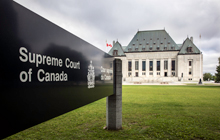The General Anti-Avoidance Rule may be expanding: What you need to know

Aron Grusko and Nick Noonan of Fillmore Riley LLP say recent legislative changes and Supreme Court decisions reflect an increasingly expansive view of GAAR
THE General Anti-Avoidance Rule (GAAR) is a section of the Canadian Income Tax Act that gives the government broad powers to prevent transactions that it deems to be against the purposes of Canadian tax law. Recent legislative changes and court decisions have broadened the applicability of the GAAR. Taxpayers should seek appropriate professional advice about their tax planning strategies.
Context
On August 4, 2023, the Department of Finance released draft legislation that would expand and strengthen the GAAR. The GAAR, set out in s. 245 of the Income Tax Act (the Act), is intended to prevent Canadian taxpayers — whether individuals, trusts, or corporations — from receiving tax benefits from tax planning that runs contrary to the purpose of the Act or its provisions (so-called "abusive" tax planning).
Since the seminal case of Canada Trustco Mortgage Co. v. The Queen, the test for the application of the GAAR has been as follows:
- Does a tax benefit result from the transaction? That is, does the transaction cause the taxpayer to pay less tax or get a larger refund than they would have if not for the transaction?
- Was the transaction giving rise to the tax benefit an avoidance transaction? An avoidance transaction will be found to exist unless the transaction, or every transaction within a series of transactions, was undertaken or arranged primarily for bona fide purposes other than to obtain the tax benefit.
- Was the avoidance transaction giving rise to the tax benefit a misuse or abuse of the Act or its provisions? This is the most subjective element of the test, but generally considers whether the relationships and transactions are inconsistent with object, spirit, or purpose of the Act's provisions; for example, by achieving an objective that the Act or its provisions seek to prevent or defeating the underlying rationale of the Act or its provisions.
If each of the following are met, the GAAR applies to deny any tax benefit that arose from the transaction.
The New Changes to GAAR
The draft legislation package is part of the 2023 Federal Budget. It was released after a consultation process in 2022 and legislative proposals first introduced on March 28, 2023. These amendments to the GAAR will apply to transactions that occur on or after January 1, 2024, except the GAAR preamble and the amendments to the related provisions, which will come into force on royal assent.
These changes represent the most significant legislative change to the GAAR since its enactment. They follow the trend of a more expansive view of the GAAR, demonstrated in recent Supreme Court of Canada decisions such as Deans Knight Income Corporation v. His Majesty the King.
The changes include the following key points:
1. A Preamble to the GAAR
The new changes would add a preamble to the GAAR, which has previously not had one. A preamble is akin to an introduction to a piece of legislation, contextualizing it and providing background.
The stated purpose of the GAAR's preamble is to "help address interpretive issues and ensure that the GAAR applies as intended." Though it has gone through modifications since first being introduced, the newly proposed preamble would outline that:
- the GAAR applies to deny the tax benefit from avoidance transactions that misuse provisions of the Tax Act while still allowing taxpayers to obtain benefits contemplated by particular provisions;
- the GAAR aims to strike a balance between a taxpayer's need for certainty in planning their affairs and the government's responsibility to protect the tax base and the overall fairness of the tax system; and
- the GAAR can apply regardless of whether a tax strategy is foreseen by Parliament (a codification of a critical element of the SCC's decision Deans Knight).
As noted above, this preamble would come into force on royal assent, and apply to any transactions occurring on or after that date.
2. A Lowered Threshold for "Avoidance Transaction"
If you thought the definition of an avoidance transaction was already a low threshold, think again. These new changes modify the current step 2 of the test - that a transaction is an avoidance transaction where it results directly or indirectly in a tax benefit, unless carried out primarily for bona fide purposes other than to obtain the tax benefit.
Instead, under the proposed rules, if a taxpayer undertakes a transaction and it can reasonably be considered that "one of the main purposes" of the transaction is to obtain a tax benefit (directly or indirectly), it would be considered an avoidance transaction. This means that a transaction conducted for primarily bona fide commercial purposes may be considered an avoidance transaction if one of its main purposes is to obtain a tax benefit.
This is a substantial broadening of the GAAR, which may cause a far greater number of transactions and taxpayers to fall within the definition of avoidance transaction.
3. A New Rule on Economic Substance
The most recent draft legislation, tabled November 21, 2023, provides that a transaction significantly lacking economic substance is an important consideration that tends to indicate it is a misuse or abuse under Step 3 of the test. There will be no misuse or abuse in "appropriate circumstances," where it can be shown that Parliament intended to encourage the effect of a particular avoidance transaction that is significantly lacking in substance, such as for transfers into a tax-free savings account (TFSA).
The new changes provide a non-exhaustive list of factors that should be considered when determining if a transaction has economic substance. The presence of one or more of the following factors supports a finding that the transaction lacks economic substance:
- there is no substantial change in the opportunity for gain or profit and risk of loss of the taxpayer and non-arm's length persons, including because of: (i) a circular flow of funds; (ii) offsetting financial positions; (iii) the timing between steps in the series; (iv) the use of an accommodation party.
- it is reasonable to conclude that the expected value of the tax benefit exceeds the expected value of the non-tax economic return (which excludes foreign tax benefits); and
- it is reasonable to conclude that the entire, or almost entire, purpose for undertaking or arranging the transaction or series was to obtain a tax benefit.
4. A New Penalty
Taxpayers who are found to have violated this new GAAR may also face a new penalty for doing so. At present, the GAAR only denies the tax benefit, plus any interest on overdue tax.
In transactions where GAAR applies, the new changes introduce a penalty calculated by reference to the tax payable as a result of applying the GAAR.
The math looks scary, but boils down to the penalty being equal to the following:
(A – B) x 25% – C
Where:
A is the tax payable by the person under the Tax Act for the year after applying GAAR;
B is the tax that would have been payable under the Tax Act if the GAAR did not apply; and
C is the amount of any gross negligence penalty payable by the person under subsection 163(2) of the Act in respect of the transaction or series, provided that this item did not already reduce the penalty payable under this subsection in a preceding taxation year.
It is also worth noting that the new changes add an exception to this penalty: Where a taxpayer can demonstrate that it was reasonable to conclude at the time a transaction or series was entered into that the GAAR would not apply to the transaction or series. This exception is narrow and meant to be limited to situations when taxpayers relied on identical or "almost identical" transactions that were either the subject of a court decision or an administrative guidance or statements that were published by the Minister of National Revenue or another relevant government authority. A dispute may arise as to what constituted an almost identical transaction.
This penalty is inapplicable if the transaction was disclosed under the mandatory disclosure transaction rules, including under the newly proposed optional disclosure rule. There are 3 'types' of these rules:
- First, reportable transactions — taxpayers may be required to report transactions if one of three hallmarks (i.e. contingent fees, confidential protection or contractual protection — as defined in the legislation) are present.
- Second, notifiable transactions, which are transactions or types of transactions that have been designated as such by the CRA. Taxpayers will be made aware of these, for instance, by a posting on the CRA website.
- Third, and notably, as optional disclosure of the transactions. Taxpayers can elect to make a voluntary disclosure of the transaction under the reportable transaction rules in section 237.3 of the Tax Act. The revised draft amendments provide that the time limit to make the voluntary disclosure is "on or before the taxpayer's filing-due date for the taxation year in which the transaction occurs." The revised draft amendments also permit late filing the voluntary disclosure up to one year after the taxpayer's filing-due date.
This optional disclosure is particularly noteworthy. While courts, accountants, and lawyers grapple with interpreting these broad changes, it is not hard to envision circumstances in which tax advisors may raise with a client that a transaction might be subject to the GAAR, and the client would be advised to report it to avoid potential penalties. The client may instead simply choose not to carry out the transaction.
5. A Longer Reassessment Period
Finally, the new changes expand the reassessment period applicable to tax reassessments under the GAAR.
The Tax Act generally provides that the CRA may at any time assess tax and other amounts payable by a taxpayer for a taxation year but may not assess after the taxpayer's "normal reassessment period" for the year. The normal reassessment period is typically 3 years. However, the new changes allow the CRA to assess within an additional 3-year period (being 6 years in total), if the assessment is made as a consequence of the application of the GAAR.
Notably, this longer reassessment period does not apply if the transaction was disclosed under the notifiable transaction rules or reportable transaction rules, including under the proposed optional disclosure rule discussed earlier. In the event that a taxpayer chooses to late-file an optional disclosure under the reportable transaction rules, the reassessment period is extended, but only by one year (not three years).
Takeaway
Recent legislative changes and Supreme Court of Canada decisions reflect an increasingly expansive view of the GAAR and its potential applicability to a wider variety of transactions. For instance, transactions undertaken for bona fide commercial purposes, but where "one of the main purposes of which" is to obtain a tax benefit, may now be caught by the expanded GAAR. This highlights the importance of receiving professional tax advice when undertaking commercial activities.
Aron Grusko is a partner and Nick Noonan is an associate at Fillmore Riley LLP in Winnipeg.









(0) Comments